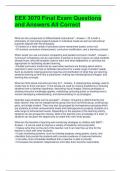EEX 3070 Final Exam Questions
and Answers All Correct
What are the components of differentiated instructions? - Answer- • DI is both a
philosophy of instructing students based on individual needs as well as instructional
practices aligned with the philosophy.
• DI draws on a wide variety of practices (some researched based; some not).
• DI involves curriculum enhancement, curriculum modification, and a learning contract.
When would you use curriculum compacting and parallel curriculum model? - Answer- •
Curriculum compacting can be used when a teacher is trying to figure out what students
already know, what the students need to learn and what adaptations or activities are
appropriate for facilitating student learning.
• Parallel curriculum model can be used when teachers are thinking about what is
important to learn and how to facilitate instructions for a wide range of student needs.
Such as students making personal meaning and clarification of what they are learning,
students learning to think like a practitioner, making key interdisciplinary linkages, and
learning key concepts.
What are think aloud and what are they for? - Answer- A metacognitive strategy used to
model how to think and learn. Think alouds are used for making predictions or showing
students how to develop hypothesis, describing visual images, sharing analogies or
showing how prior knowledge applies, verbalizing confusing points or showing how to
monitor developing understanding, and demonstrating fix-up strategies.
Describe ways students can be grouped? - Answer- Grouping is determined by two
basic factors: they can be categorized by group size such as whole group, small group,
pairs, and single student. They may also be grouped by homogeneous grouping which
are students at similar achievements levels and heterogeneous grouping, students at a
wide range of achievement levels. Depending on the purpose of the learning activity,
students can be grouped by interest, skills to be learned, prior knowledge of a topic, or
students can be given the opportunity to create their own small groups.
What are the benefits of teaching self-monitoring strategies to children with EBD? -
Answer- • It can be used to improve a variety of academic and social skills.
• It takes extra time on the part of the teacher, but it can help free up time for the
teacher to work with other students.
• It uses monitoring systems, such as charting progress using graphs, charts, and
checklists that provide the students with concrete evidence of improved behavior.
• It provides more immediate feedback than a teacher is able to provide.
• It increases the students' independence and helps them become responsible.
, • It facilitates communication with parents by providing data that can easily shared
during a meeting.
• It encourages individual improvement rather than competition across students, so
each student can work toward his or her own goal.
What are the reasons Kauffman (2004) gives for the under-identification of students with
EBD in schools? - Answer- • Social sigma is associated with the label "seriously
emotionally disturbed."
• Eligibility for categorization as emotionally disordered is mot clearly defined.
• The identification process lacks uniformity.
• Co-morbidity (student having more than one disability) can make identification difficult.
• A lack of funding may limit school districts' willingness to identify and provide services
for these students.
• There is often a lack of appropriate services when students are identified, and
identification limits a school's ability to take disciplinary action against misbehavior.
• Adequate assessment measures to facilitate identification are few
Give examples of externalizing behaviors - Answer- Conduct disorders, acting out,
aggression, tantrums, and bizarre behaviors.
Give examples of Internalizing behaviors? - Answer- Fear, immaturity, tenseness,
withdrawal, and worry
If a student is working in a small group and receives interventions regarding self-control
and self-management skills training he/she would be in at least which RTI tier? -
Answer- Tier 2; interventions are typically small-group interventions that can provide
students with the self-control, self-monitoring, social, and self-management skills they
need to benefit from universal strategies
Externalizing behaviors - Answer- Behaviors such as aggression, hitting, and shouting
that are readily observable and tend to affect others.
Internalizing behaviors - Answer- Behaviors such as shyness, withdrawal, or depression
that tend to be less readily observable and negatively affect the individual exhibiting the
behaviors.
Characteristics of students with a conduct behavior - Answer- Ignoring the rights of
others, cruel, destructive, deceitful, and truant
Socialized-aggression - Answer- Routinely engaging in antisocial behavior
Anxiety-withdrawal - Answer- Students withdraw from others and appear reclusive,
preferring solitary activities. Often timid, or bashful around others; exhibit tendencies of
perfectionism




